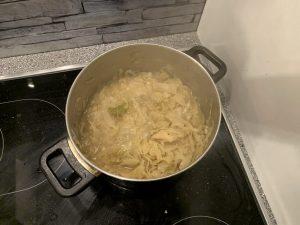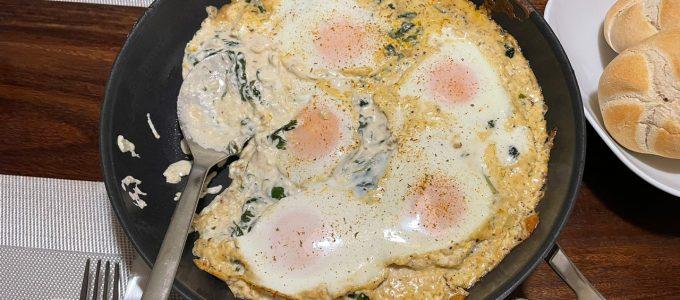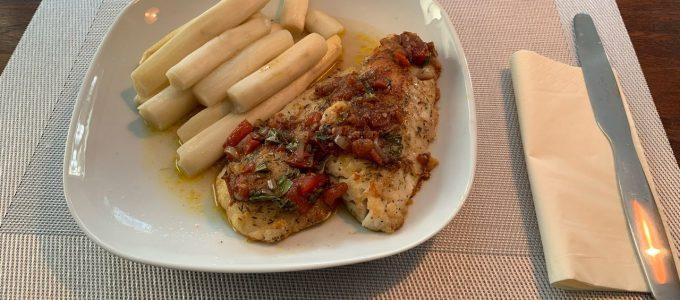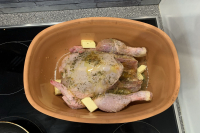It’s cold outside. And rainy. And generally clammy and deterrent – I’m so, so done with this wintery weather. A good time for hot, filling and delicious comfort food, served with toasted bread, directly from the pan.
Creamy Savoy Cabbage Recipe
There’s a popular northern germany dish called “Grünkohl mit Pinkel” (Stewed Kale and Pinkel Sausage), that I like very much. Now, running out of kale… somehow… I decided to just substitute it with creamy savoy cabbage (german “Rahmwirsing”) from the local grower and it worked fine.
It’s simple and it only takes 15 minutes to cook, yet it’s delicious. And here’s how:
Easy and un-elaborate Turkey Strips and Veggies
We’re having this 20 year old northern germany kitchen remodeled in the next few days. Thus we had to clear out everything and will now have to do with a minimum of kitchen equipment and cooking options for about a week or so. And this, in return, means simple and no-fuzz cooking.
This was the first day of “Camp Kitchen”: Creamy turkey strips with potatoes and balsamic brussels sprouts. (Sounds like big words, but it’s actually simple:-) ).
Sauce Vierge
The sauce vierge is a traditional french, meditarranean-style, infused sauce invented by some super important french cooking guy several decades ago. Goes very deliciously with fish, and that’s what I had yesterday.
Rillettes de Poulet
Well, I’m really into cooking, but these days I stumbled upon something completely new to me again: Rillettes. A french type of shredded strands of pork/chicken/duck or even fish as a soft and savoury spread for toasted bread and the like.
Meat or poultry or whatever is cooked over a long period of time until very tender and aromatic, then frayed and mixed with it’s own juices and rendered fat. Stored in a glass jar and topped with a layer of fat for preservation this is a hearty, savoury and addictive addition to a rustic and “good and solid” dinner. Obviously, this is not for the calorie-conscious…
How to: Prepare Sauerkraut…
 … the traditional german way – or not?
… the traditional german way – or not?
Sauerkraut is so german it even gave us our name 🙂 , it’s very widespread in the nation, very regionally diverse and versatile. It is part of the traditional german cuisine, mostly eaten as a side dish but also as a full meal when made with the appropriate ingredients. It’ very healthy – for example for it’s contents of vitamin C which even increases when cooked.
There’s what feels like a gazillion ways of preparing (especially homemade) Sauerkraut in germany alone (and I bet there are even more recipes all over the world). To condense these down to some kind of a standard formula that everything else can be built upon, here’s my way. BTW: We’re talking fresh and unprocessed Sauerkraut here, not the pre-cooked, canned version from the supermarket.
Home Made Sauerkraut Tutorial
Update october 2020: New sauerkraut, substantially more information added 🙂
Since I happen to be a “Kraut” by birth, I decided to home-make my own Sauerkraut. Fermentation using wild lactobacillus is an ages-old and easy way of preserving almost every reasonably hard/crunchy vegetable (read more here and here) you like. It’s easy and for our grandparent’s generation it was a perfectly common thing to do.
So what is this “fermentation thing” all about? In short: Fermentation is latin and means the decomposing of carbohydrates in foods by various bacteria or yeasts with no oxygen around. Besides improving digestability, this produces a wide variety of distinct aromatics and other substances, the most important one being acid (lactic acid in this case). Harmful bacteria cannot thrive in an oxygen-free, acidic environment, thus, our food becomes preserved.
Crispy Browned Potato Rounds
Pan fried potato rounds. It feels like it’s been ages since I had these the last time as a kid from my aunt. I missed them… Basically, these are flattened german potato dumplings (Kartoffelklöße) fried in butter to golden brown deliciousness. Here’s how:
All Categories:
- Common (77)
- DIY Projects (161)
- Fire & BBQ (50)
- Garden & Growing (49)
- Knife making (40)
- Recipes & Kitchen (247)
All Tags:
Chickens & Pets · How Tos · Lada Niva · Manly Hints · Nice to Know · Plans & Info · Prepping · Reading · Reviews & Products · Sticky · Travel
I’m (somewhat) social, too!






























































































